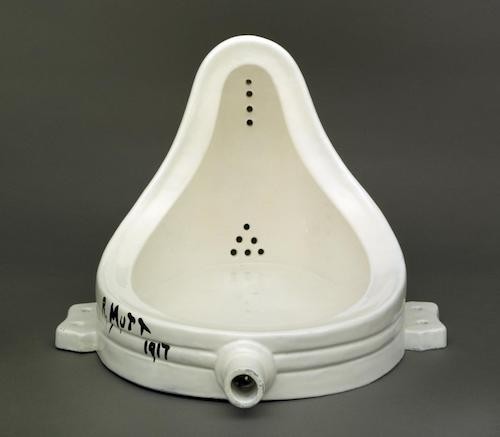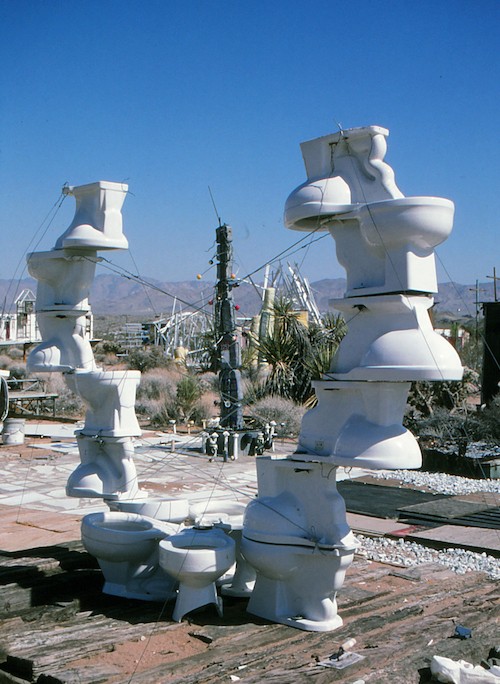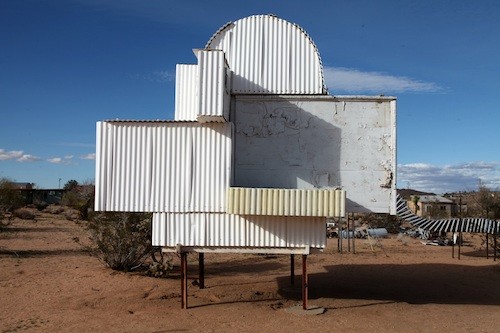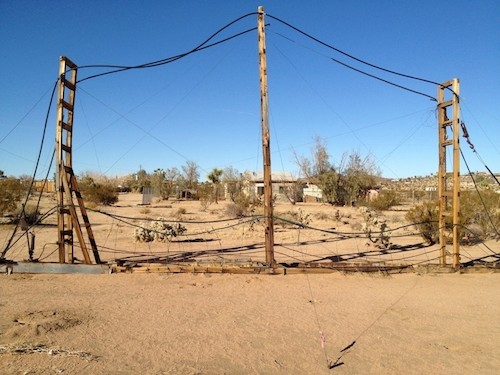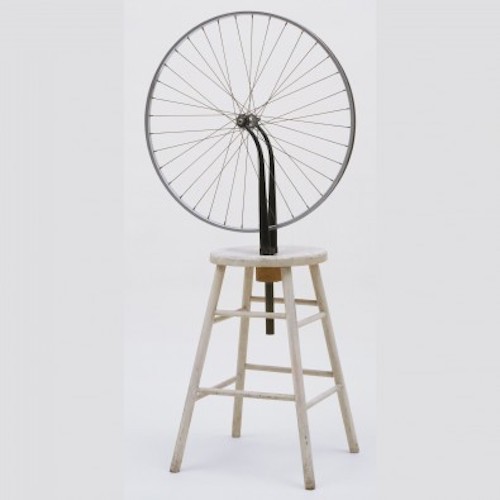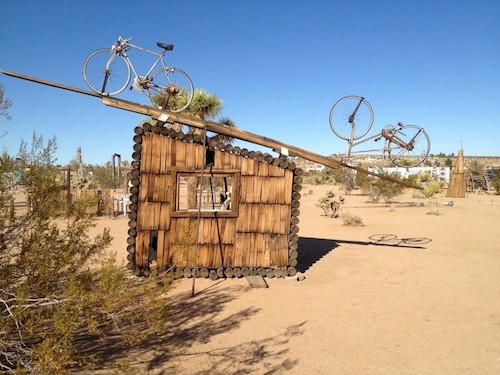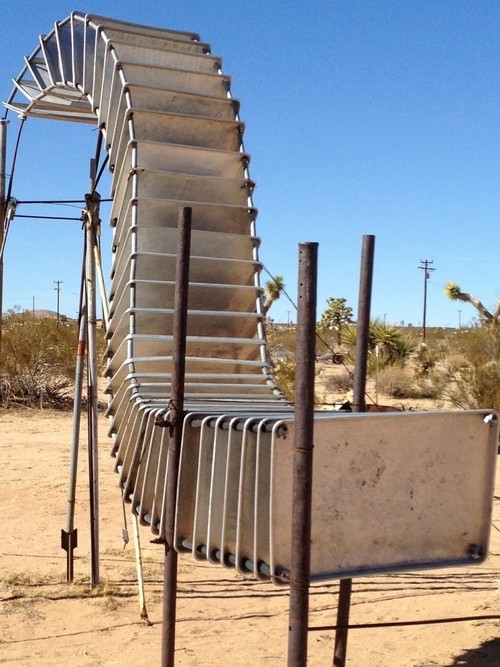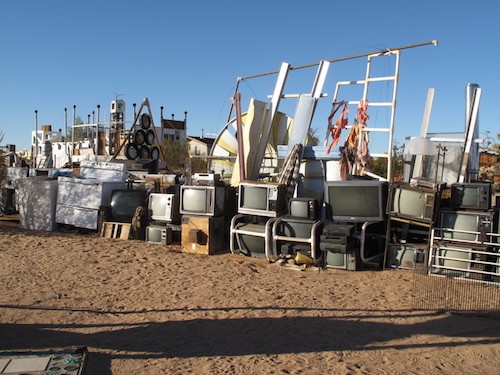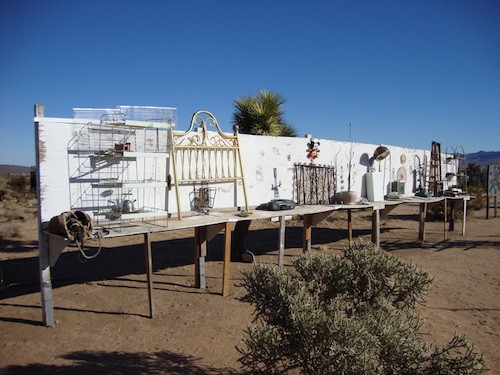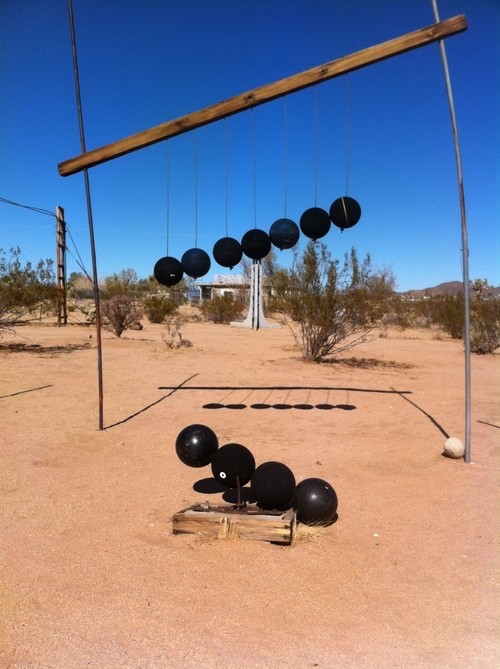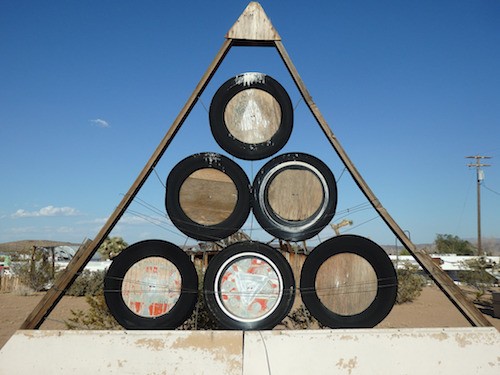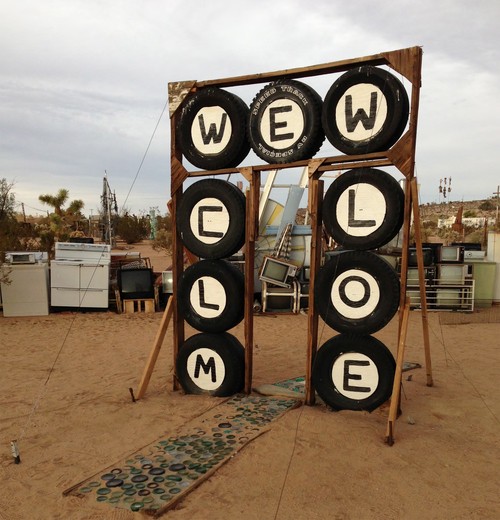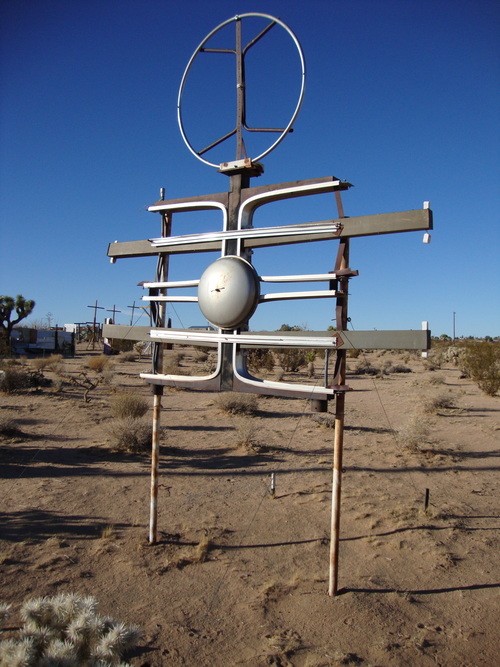66 Signs of Noah: Purifoy's Forms

Junk Speak
Trash gyres, pre-objective monumentality, a rental.
—Lisa Robertson
I can’t be the only one who’s looked at Duchamp’s “Fountain” and thought what beautiful things toilets are.
The sinuous, vaguely anthropomorphic shape; the porcelain’s serene shine; the holes in two groups of esoteric Morse. Whatever its renegade intentions, Duchamp’s urinal hints at the totemic powers any of our everyday objects might carry, if we just learned to look the right way.
Now look what Noah Purifoy does with toilets eighty years later:
You could set a whole history of the century between these two parentheses. Europe to U.S.; East Coast to Left; gallery to ecoscape; “R. Mutt” to city dump. Both remind me too how the toilet itself may be the great poem of modernity, emblem of the hygiene, sanitation, and longevity that underwrites its obvious inequities.
The special, late-century kind of poetry in Purifoy’s toilets, I think, has something to do with how he plays down the singular object—so front and center in Duchamp’s piece—to draw the attention to relations. That snaky grammar that runs through his flipped arch wouldn’t be visible without the syntax of multiples (and their funny inversions), just as the desert behind it wouldn’t come into such focus without the empty, vaguely Zen center he’s left.
Duchamp confronts us with a thing, which then changes the meaning of the space around it; Purifoy creates a site where things seem to take position—like a sentence in meter—according to the previously unsuspected logic of the space. Like Ezra Pound’s idealized Chinese characters, his piece turns Duchamp’s gleaming noun into a frozen verb.
By the time Purifoy died in 2004, he’d left a whole primer of forms like this in the California desert: witty, open-ended, highly personal interventions into a history of Modern art that had made small place for him, spread over his own ten acres in the Mojave, no museum in sight but not far from the 100-million-year-old formations in Joshua Tree National Park.
Purifoy’s work gives tangible form to much of what I love about poetry. Poems are small things with giant ambitions—even Pound’s “poem including history” doesn’t take up much space on a shelf. In theory, a pen and a drugstore notebook can launch you into immortality. The low cost of entry and warped sense of scale are part of the art’s appeal for me, and Purifoy’s DIY assemblages cue the same tickle I get when a good poet moves the room with a few sheets of paper and a mike.
Here’s Purifoy, with a poet’s economy, putting himself into conversation with Frank Gehry:
The title—“Ode to Frank Gehry”—suggests an homage, but is it also a sly dig? With some old shipping crates and a few buckets of paint, Purifoy’s dodged the architect’s need for all that capital, achieves the same forms outside the dictates of clients and permits and partners and girders. By miniaturizing the monumental—re-making it smaller in junk—he’s democratized monumentality, showing how any one of us could do it. But in reducing it, he also cuts the legs out from under it (or exposes the thin legs it stands on). His ode is a tribute—“a kind of poem usually praising something”—but I also see in it a caution that immortality at scale may come at too high a price.
Here he does it again with something more civic, less eccentric than a Gehry: the San Francisco-Oakland Bay Bridge.
A bridge in the desert, going nowhere, brought down from epic to lyric size; the punchline to a missing joke. By dropping the cities on either side—a conjunction relieved of its sentence—Purifoy shifts the weight of perception from the object’s function to its elemental forms: the stanchions and loopy wires, ribs and tensed lines, now free of the need to support anything. Like a visual poem strips words of their usual uses, so you can see them as just shapes, Purifoy’s form extracts from the bridge its ‘bridgeness’ and sets it down in the desert with nothing to do but activate the unexpected setting.
But as any poet knows, a word can’t slip its semantic load any more than Purifoy’s bridge can make you forget the water it ought to be spanning, or the SF and Oakland it’s meant to connect. That loose but persistent allusion to the thing it represents energizes many of Purifoy’s objects, putting them into a wry, elusive relationship with their originals.
Is Purifoy’s bridge an abbreviated hymn to one of the great modern forms, like Hart Crane’s? A surreal juxtaposition—Bay Bridge with flat desert—to stir the transformative powers of the Unconscious? A meditation on futility? An outsider’s brazen claim of public authority? A phenomenologist’s test (Purifoy was a great reader of Heidegger and Husserl) of how little you need to call a bridge into being? A political statement, as Abigail DeVille reads it, evoking “protests and activists crossing bridges,” Selma to Birmingham?
Like any memorable poem, Purifoy’s bridge bears all those meanings, plus others you’re bound to come up with. His poiesis, or way of making, works to open up relations—between the object and its surroundings, a sign and its meanings—by leaving them just a little opaque.
Living alone in the desert, forging his private diction of castaway forms, Purifoy puts me in mind of those poets from the other end of the century, like Cavafy or Pessoa, who tilted the course of Modern poetry with the smallest of means: a handful of poems, a trunkful of papers. Their monuments, like Purifoy’s—like any poet’s, whose materials are the words we throw out every day—are built up from the overlooked stuff of ordinary life.
Nothings Doubled
That’s what I do, I repeat.
—Noah Purifoy
Let’s put Duchamp up next to Purifoy again:
Duchamp’s austere wheel depends on a base where you’re supposed to sit, but pointedly can’t; Purifoy’s bikes top a place you might dwell.
Part of the fun in Purifoy’s forms comes from the number of stories you can rest on any one of them. One story here might be about inequality, the evils of an uneven playing field. Or about escape—the Great Migration, say, where wheels took folks like Purifoy out of rural shacks and into the promise (and tragic reversals) of ‘up north’ and ‘out west.’ At its root, the piece for me evokes any top-bottom dyad—Lucky and Pozzo to Abbott and Costello—that holds out an ideal of parity, but works like the fix is in. The title he gave it? “No Contest.”
Undergirding any potential readings is a masterful play of forms. The four wheels—mirrored images—rhyme with the cylinders that frame the shingled wall, while the sloped plane they race on picks up the straight edges of the window frame and shingling to build a tension between circles and lines in which, like the eternally suspended bike race, neither ever wins.
Purifoy’s work is never purely formal (whose ever is?), and he doesn’t shy away from the overtly political.
But his symmetries—even this one, which laces its upfront message with a pun on the waterless desert surroundings (like his bridge) and connects with the grammar of other toilets he’s set throughout the site—have a way of containing and exceeding any meanings you care to give them.
Things that would amount to next to nothing on their own—an aluminum tray, a broken TV, a disused tire—project a serenity and, even at their quirkiest, a majesty, through the forms Purifoy finds to place them in. Maybe I like them so much because they remind me of untranslated sentences.
By doubling the nothings—making ciphers repeat in a sequence—Purifoy lends a meter to his objects that provokes the irreverent (how can you see these and not smile?) while invoking the sacred: items set apart for mysteries.
Robert Hass, in his recent A Little Book on Form, cites Robert Duncan’s own feel for the mysteries of form in The Structure of Rime: “An absolute scale of resemblance and disresemblance establishes measures that are music in the actual world.”
Purifoy’s forms feel tuned to a similar scale. A meter of slight differences—visual analogue for the alternation of stressed and unstressed syllables in prosody—moves out, via doubling and repetition, from the everyday to the absolute and back again. A typical Purifoy piece holds the silly and the sacred, the mundane and mystical, poised in “established measure.” For me, his assemblages realize Lyn Hejinian’s heady simile in The Cell: “Thinking is like the composition/of things.”
We Welcome
Nothing fits, but everything works.
—David Hammons
The gateway to Purifoy’s world (though it’s a gate you can step around, the kind that lets anyone through) is made from a visual poem.
Everyone I’ve shown this to reads WELCOME in the tires, easily and instantly. But how is it we get there so quickly, despite the eccentric orthography? The two W’s in the top row help, so in the place where a reader’s most likely to start, you get the friendly push of the WE. And the doubled L’s ensure you’ll hit a WEL no matter which jamb the eye goes down. By grouping the tires into three soulful triads—a mystic 9—Purifoy subtly orders the scramble and endows the letters with a self-contained equanimity.
But once we get to WELCOME, what I keep coming back to is that extra WE up top: “WE WELCOME.” Who is it that’s Purifoy’s “We”? Who’s his door meant to let in?
One “We” is unmistakably African American. Born in Jim Crow Alabama, Purifoy’s postwar roots ran deep in LA’s “South of Pico” scene of the 1960s and 1970s. It’s a powerhouse group, mixing figures like David Hammons, Senga Nengudi, John Outterbridge, Betye Saar, and Charles White with the neighborhood artists Purifoy taught as a founder of the Watts Towers Arts Center. (Kellie Jones sheds new light on this dynamic period in her essential Now Dig This: Art and Black Los Angeles 1960-1980 and South of Pico: African American Artists in Los Angeles in the 1960s and 1970s.) Thinking of his gate in the context of segregation, the Civil Rights Movement, and the Watts rebellion of 1965—which Purifoy responded to by organizing the seminal “66 Signs of Neon” show, featuring art made out of debris from the riots—WE WELCOME is a forceful statement of inclusion and communal assertion.
Purifoy’s “We” also opens out to the arts of the Afro-Atlantic, whose various ways of making and being Robert Farris Thompson charts in his Aesthetic of the Cool.
Describing what’s distinctive about that capacious family of sounds, objects, movements, gestures, and philosophies linking West and Central Africa with its transatlantic diasporas, Thompson points to an emphasis on “being comoved.” That’s a little awkward and improvised—it doesn’t quite fit, but it works. It works to describe something of what you might feel as you wander through Purifoy’s homemade cosmogram; works to convey a sense of what it wants from you, what it makes you want to give to it. It’s an object lesson too, in our silicon moment, that things don’t have to fit to work, work all the better sometimes for not fitting.
As more people find their way to Purifoy’s work, the “We’s” start to multiply. There’s his cohort of West Coast assemblage artists, for instance; near contemporaries like Wallace Berman, George Herms, Ed Kienholz, or Bruce Conner (whose restless intelligence reminds me of Purifoy’s). Or the broad company of mavericks he’s grouped with in the current “Outliers and American Vanguard Art” exhibition, where Purifoy (along with Nengudi, Outterbridge, and Saar) sits alongside the likes of Henry Darger, Judith Scott, Martín Ramírez, and Sister Gertrude Morgan.
But visiting his Outdoor Museum in Joshua Tree, off the main road and not easy to find, Purifoy’s “We,” like the interpretations his work invites, feels wide enough to include anyone who takes the trouble to bump down the dirt trail in desert weather, following the hand-inked sign with an arrow that reads, “To Noah’s.”
Purifoy’s forms won’t be there to comove us forever. Punishing heat and high winds have already destroyed a few of the pieces. And so far, despite a hike in visitors and the risk of vandalism, the Noah Purifoy Foundation has stayed true to his vision of “a museum with no fence, free and open to the community.” Purifoy himself saw the erosion of his assemblages as inevitable, an inherent part of art-making. The act of creating weighed more with him than the finished product. “In essence,” he wrote, “Art and Creativity/are eons apart.…Art is what people/say about Creativity.”
But for as long as it lasts, Purifoy’s work is there to supply what Artaud said he found in the poems of Arthur Rimbaud: “a new way of maintaining ourselves in the midst of things.”
Let’s leave the last word to one of Noah’s poems:
A Book Flown
These fragmentations only mean that
I am fragmented,
That as I symbolize what you say and agree
Can I then leave you
To set these lines in order,
Assemble them into a book
And by the first strong winds,
Permit its leaves to be torn from its cover.
Let them fly high and, like leaves,
Light into the lap of the Universe
Separate of and by themselves
Within without complete
Yet incomplete.
(Courtesy of Noah Purifoy Foundation ©2018)
Koeneke was born in Omaha, Nebraska, and grew up in Tucson, Arizona, and Los Angeles. He is the author...
Read Full Biography


